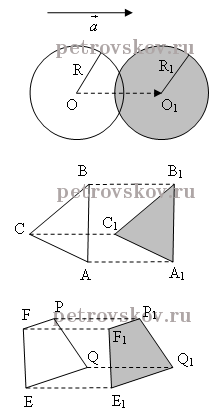The contents of this webpage:
- the angles of the triangle,
- the area of the triangle through the legs and the hypotenuse,
- the calculation of the radius of the circumscribed circle,
- the side of the rhombus,
- the similar triangles.

The parallel transfer onto a vector ![]() is a mapping of the plane onto itself if the following conditions hold: each point M is mapped to the point M1 such that two vectors are equal.
is a mapping of the plane onto itself if the following conditions hold: each point M is mapped to the point M1 such that two vectors are equal.
![]() =
= ![]()
***
Given:

the segment AB
Build:
AB → A1B1
A → A1 : ![]() =
= ![]()
B → B1 : ![]() =
= ![]()
***
Theorem:
With the parallel transfer to the vector ![]() the distance between the points is kept, i.e. the parallel transfer is the motion.
the distance between the points is kept, i.e. the parallel transfer is the motion.
Given:
f is the parallel transfer to the vector ![]()
M ![]() M1
M1
N![]() N1
N1

f is the motion (MN = M1N1)
Proof:
The point M is translated by the motion to the point M1 with the condition that the two vectors are equal: M ![]() M1:
M1: ![]() = MM1
= MM1
The point N is translated by the motion to the point N1 with the condition that the two vectors are equal: N![]() N1:
N1: ![]() = NN1
= NN1
Therefore, the obtained segments are parallel MM1 || NN1 and the constructed segments are equal MM1 = NN1
Therefore, the quadrilateral MM1N1N is the parallelogram.
Therefore MN = M1N1, then f is the motion.
***

a)
the triangle ΔABC
A ![]() A1:
A1:
![]() =
= ![]()
B ![]() B1:
B1:
![]() =
= ![]()
C ![]() C1:
C1:
![]() =
= ![]()

b)
the triangle ΔABC
A ![]() A1:
A1: ![]() =
= ![]()
B ![]() B1:
B1:
![]() =
= ![]()
C ![]() C1:
C1:
![]() =
= ![]()

Given:
the triangle ΔABC
AB = BC
the point D lies on AC: D![]() AC
AC
the point C lies on AD: C![]() AD
AD
BC ![]() B1D
B1D
a) Build: B1D
b) Prove: ABB1D is the isosceles trapezoid
a)
Construction:
1) draw the line a from the point B parallel to the vector ![]() : a ||
: a || ![]()
2) the point B is translated by the motion to the point B1
![]() =
= ![]()
3) draw the line B1D parallel to the segment BC:
B1D || BC
***
b)
Proof:
Consider the quadrilateral BB1DC.
Since the bases of BB1 || CD and the lateral sides BC || BD are parallel, we see that BB1DC is the parallelogram (by the definition)
By the property of the parallelogram:
the bases BB1 = CD and the lateral sides BC = BD are equal, but AB = BC, then AB = B1D
Since BB1 || AD are parallel and AB ![]() B1D are not parallel, therefore ABB1D is the trapezoid (by the definition).
B1D are not parallel, therefore ABB1D is the trapezoid (by the definition).
Since AB = B1D, we see that ABB1D is the trapezoid (by the definition).
***
Given:

the triangle ΔABC
EFPQ is the trapezoid
the circle (O; R)
the vector ![]()
Build:
circle (O;R) ![]() circle (O1;R1)
circle (O1;R1)
ΔABC ![]() ΔA1B1C1
ΔA1B1C1
EFPQ![]() E1F1P1Q1
E1F1P1Q1
Construction:
as it is shown on the picture.
***
Definition:

![]() MOM1 = α and OM1 = OM.
MOM1 = α and OM1 = OM.
O is the center of the rotation
α is the angle of the rotation
***

α = 75° (counter-clockwise)
O is the center of the rotation
AB is the segment
Build:
A1B1
Construction:
1) A![]() A1;
A1;
![]() AOA1 = 75°
AOA1 = 75°
OA = OA1
2) B![]() B1;
B1;
![]() BOB1 = 75°
BOB1 = 75°
OB = OB1
***
Theorem:
The rotation is the motion.
Given:

α is the angle of the rotation (counter-clockwise)
the point O is the center of the rotation
MN is the segment
Prove:
f is the motion, MN = M1N1
Proof:
Let M→M1; N→N1
Then the triangles are equal ΔOMN = ΔOM1N1 by two sides and the angle between them:
OM = OM1
ON = ON1
![]() MON =
MON = ![]() M1ON1
M1ON1
Then MN = M1N1, therefore, f is the motion..
***
Given:
the point O is the center of the rotation

AB is the segment
AB→A1B1
Build:
A1B1
Construction:
1) A![]() A1;
A1;
![]() AOA1 = 180°
AOA1 = 180°
OA = OA1
2) B![]() B1;
B1;
![]() BOB1 = 180°
BOB1 = 180°
OB = OB1
***
Given:
the triangle ΔABC
the point A is the center of the rotation
α = 160° (counter-clockwise)
ΔABC→ΔAB1C1
Build: ΔAB1C1
Construction:
1) B![]() B1;
B1;
![]() BAB1 = 160°
BAB1 = 160°
BA = B1A
2) C![]() C1;
C1;
![]() CAC1 = 160°
CAC1 = 160°
CA = AC1
***
Given:
the point O is the center of the rotation
α = 120°
AB is the segment
AB→A1B1

A1B1
Construction:
1) A![]() A1;
A1;
![]() AOA1 = 120°
AOA1 = 120°
OA = OA1
2) B![]() B1;
B1;
![]() BOB1 = 120°
BOB1 = 120°
OB = OB1
***
Given:
the point C is the center of the circle (C; R)
the point O is the center of the rotation
the rotation angle α = 60° (counter-clockwise)
a) the point C and the point O do not coincide
b) the point C and the point O coincide

circle (C1; R)
Construction:
a)
1) we draw the ray CO
2) C![]() C1;
C1;
![]() COC1 = 60°
COC1 = 60°
CO = C1O

b)
Since the point O as the center of rotation and the point C as the center of the circle coincide, we see that the circles (C;R) and (C1;R) will also coincide.
***

Given:
Δ ABC is the isosceles, equilateral triangle
D is the point of intersection of the bisectors
D is the center of the rotation
the rotation angle α = 120°
Prove:
ΔABC![]() ΔABC
ΔABC
Proof:
Since Δ ABC is the regular triangle, we see that all angles of it are equal to 60°.
Since the point D is the center of the circumscribed and inscribed circle, we see that
AD = BD = DC = R.
Δ ABD = Δ BDC = Δ DAC (by three sides).
Therefore that ![]() ADB =
ADB =![]() BDC =
BDC =![]() CDA
CDA
Therefore
A![]() B
B
B![]() C
C
C![]() A
A
I.e. ΔABC → ΔBCA.
So, Δ ABC is mapped to itself.
***
Revising.
Given:
the triangle ΔABC
the ratio of the angles
![]() ABC :
ABC :![]() BCA :
BCA :![]() CAB = 3 : 7 : 8
CAB = 3 : 7 : 8
Find: the largest angle of the triangle
Solution:
Let x be the coefficient of the proportionality. Knowing that the sum of the angles in the triangle is 180°, we compose and solve the equation:
3x + 7x + 8x = 180
18x = 180
x = 10
The largest angle is ![]() CAB = 8 • 10 = 80°
CAB = 8 • 10 = 80°
Answer: 80°.
***
Given:
the triangle ΔABC is the isosceles triangle,
one angle is greater than the other:

Find: the angle at the base of the triangle
Solution:
Let x° be the angle at the base of the triangle. Knowing that the sum of the angles in the triangle is 180°, we will compose and solve the equation:
(x + 60°) + x + x = 180°
3x = 180 – 60
3x = 120
x = 40
Therefore, ![]() BAC = 40°.
BAC = 40°.
Answer: 40°.
***
Given:
the triangle ΔABC is right
c = 26 cm is the hypotenuse
the ratio of the legs:
a : b = 5 : 12
Find: the greater leg b
Solution:
Let x be the coefficient of the proportionality. By the theorem of Pythagoras we compose and solve the equation:
(5x)2 + (12x)2 = 262
25x2 + 144x2 = 676
169x2 = 676
x2 = 4
x = 2
b = 12 • 2 = 24 (cm)
Answer: 24 cm.
***
Given:
the triangle ΔABC,
![]() C = 90°
C = 90°
b = 5 is the leg
c = 13 is the hypotenuse
Find: the area of the triangle SΔABC = ?
Solution:
By the Pythagorean theorem we obtain:
a =![]() =
=![]() =
=![]() = 12
= 12
Then the area of the triangle
SΔABC = ![]() • ab =
• ab = ![]() =
=
= 30 (square units)
Answer: 30 square units.
***
Given:
the triangle ΔABC is isosceles,
![]() C = 90°
C = 90°
c = 4![]() is the hypotenuse
is the hypotenuse
Find: the area of the triangle SΔABC = ?
Solution:
SΔABC = ![]() • ab
• ab
Since Δ ABC is isosceles, we see that the angles at the base of 45° and the legs are a = b.
By the Pythagorean theorem we obtain:
c2 = a2 + b2 = a2 +a2 = 2a2
Then (4![]() )2 = 2a2
)2 = 2a2
a2 = 16
a = 4 (unit)
Then the area of the triangle
SΔABC = ![]() • ab =
• ab = ![]() =
=
= 8 (square units)
Answer: 8 square units.
***
Given:
the triangle ΔABC,
![]() A = 90°
A = 90°
AH is the median

b = 8
Find: the radius of the circumscribed circle R = ?
Solution:
Since AH is the median, we see that CH = ![]() c
c
By the Pythagorean theorem we obtain:
c2 = a2 + b2
c2 = 36 + 64
c = 10 (units)
Then CH = ![]() c =
c = ![]() = 5 (units)
= 5 (units)
The point H is the center of the circumscribed circle
AH = BH = CH = R
Since R = AH, we see that R = AH = CH = 5 units.
Answer: 5 units.
***
Given:
the triangle ΔABC,
![]() C = 90°
C = 90°
the ratio of the acute angles
![]() ABC :
ABC : ![]() CAB = 1 : 2
CAB = 1 : 2
AC = 4![]()
Find: the radius of the circumscribed circle R = ?
Solution:

x + 2x + 90 = 180
3x = 90
x = 30
Then ![]() CAB = 30°,
CAB = 30°,
![]() ABC = 2 • 30° = 60°
ABC = 2 • 30° = 60°
Therefore, BC = ![]() AB
AB
By the Pythagorean theorem we obtain:
AC2 + BC2 = AB2
AC2 + ![]() = AB2
= AB2
AC2 = ![]() AB2
AB2
AB2 = ![]() = 64
= 64
AB = 8 (units)
R = AD = BD = 8 : 2 = 4 (units)
Answer: 4 units.
***
Given:
the triangle ΔABC,

BC = 3
the radius of the circumscribed circle
R = 2.5
Find: AC = ?
Solution:
R = AH = BH = 2.5
Then AB = 2.5 • 2 = 5
By the Pythagorean theorem we obtain:
AC = ![]() =
= ![]() =
= ![]() = 4 (units)
= 4 (units)
Answer: 4.
***

Given:
the triangle ΔABC,
![]() C = 90°
C = 90°
tg A = 0.6
BC = 3
Find: AC = ?
Solution:
tg![]() A =
A = ![]()
0.6 = ![]() ; AC = 3 •
; AC = 3 • ![]() = 5 (units)
= 5 (units)
Answer: 5.
***
Given:
the triangle ΔABC,
![]() A = 90°
A = 90°
AH = AC
Find: ![]() ABC = ?
ABC = ?

Since AH = AC, we see that Δ AHC is isosceles.
The point H is the radius of the inscribed circle, so AH = CH, but AH = AC, therefore, AH = CH = AC.
Then Δ AHC is equilateral.
Therefore, ![]() HAC = AHC =
HAC = AHC = ![]() HCA = 60°.
HCA = 60°.
![]() ABC = 180° – (90° + 60°) = 30°.
ABC = 180° – (90° + 60°) = 30°.
Answer: 30°.
***
Given:
the triangle Δ ABC is regular, equilateral,
the area of the triangle
SΔABC = ![]() square units
square units
Find: the length of the bisector BH = ?
Solution:

Consider Δ ABC is isosceles, where
![]() BAC =
BAC = ![]() BCA = 60°.
BCA = 60°.
Then BH is the median, the height.
Therefore, the segments are perpendicular: BH ![]() AC.
AC.
Consider the triangles Δ ABH and Δ BHC.
AB = BC, by the given hypothesis.
AH = CH, BH is the median.
BH is the common side.
Therefore, the triangles are equal Δ ABH = Δ BHC.
The area of the triangle is SΔABC = 2SΔABH
I.e. SΔABH = ![]() SΔABC =
SΔABC = ![]() •
• ![]() =
= ![]() (square units)
(square units)
SΔABH = ![]() AH • BH
AH • BH
Consider the triangle Δ ABH.
Since BH is the bisector, we see that the angle ![]() ABH = 30°, therefore
ABH = 30°, therefore
AH = ![]() AB
AB
SΔABH = ![]() AB • BH =
AB • BH = ![]()
AB • BH = ![]() (*)
(*)
By the Pythagorean theorem we obtain:
AB2 = AH2 + BH2
AB2 = ![]() AB2 + BH2
AB2 + BH2
BH2 = ![]() AB2
AB2
BH = ![]() AB (**)
AB (**)
Using the result (**) in equation (*), we obtain
AB • ![]() AB =
AB = ![]()
AB2 = ![]()
AB = ![]()
Then AB • BH = ![]()
![]()
![]() • BH =
• BH = ![]()
BH = 1 (unit)
Answer: BH = 1 unit
***
Given:
the triangle Δ ABC is regular, equilateral,

R = ![]()
Find: the area of the triangle
SΔABC = ?
Solution:
Consider Δ ABO (AO = BO = R) ![]() Δ ABO is the isosceles triangle.
Δ ABO is the isosceles triangle.
We draw the height OH from the vertex O to AB.
Consider Δ AOH, where ![]() AHO = 90°.
AHO = 90°.
Since ![]() HAO = 30°, we see that OH =
HAO = 30°, we see that OH = ![]() AO
AO ![]() OH =
OH = ![]() R
R
OH = ![]() •
• ![]() =
= ![]()
By the Pythagorean theorem we obtain:
OH2 + AH2 = OA2
OH2 + AH2 =R2
![]() + AH2 = (
+ AH2 = (![]() )2
)2![]()
![]() + AH2 =
+ AH2 =
= ![]()
AH2 = ![]() –
– ![]() =
= ![]()
![]() AH =
AH = ![]() =
= ![]()
Then the area of the triangle
SΔAOH = ![]() AH • OH =
AH • OH = ![]() •
•![]() •
•![]() =
= ![]() =
=![]()
Therefore, SΔABO = 2 • SΔAOH = 2 • ![]() =
= ![]() (square units)
(square units)
Then the area of the triangle
SΔABC = 3 • SΔABO = 3 • ![]() =
= ![]() = 2
= 2![]() = 2.25 (square units)
= 2.25 (square units)
Answer: 2.25 square units
***

Given:
the rhombus area is SABCD = 384
the ratio of the diagonals of the rhombus:
AC : BD = 3 : 4
Find: the rhombus side AB = ?
Solution:
the area of the rhombus
SABCD = ![]() AC • BD
AC • BD
Let x be the coefficient of the proportionality. Then
SABCD = ![]() 3x • 4x
3x • 4x
384 = 6x2
x2 = 64
x = 8
Therefore, the diagonal BD = 4x = 4 • 8 = 32
AC = 3x = 3 • 8 = 24
AC = 2AO
BD = 2BO
Therefore, half the diagonal AO =![]() AC =
AC = ![]() • 24 = 12
• 24 = 12
BO =![]() BD =
BD = ![]() • 32 = 16
• 32 = 16
By the Pythagorean theorem we obtain:
AO2 + BO2 = AB2
The side of the rhombus is AB =![]() =
=![]() = 20
= 20
Answer: 20.
***
Given:
the triangle Δ ABD is isosceles,

the side AB = 10
Find: the area of the triangle
SΔABD = ?
Solution:
the area of the triangle
SΔABD = ![]() AD • BH
AD • BH
We draw the height BH to the base AD.
By the property of an isosceles triangle:
BH is the median, the bisector, the height.
Since BH is the median, we see that AH = DH = 16 : 2 = 8 (unit)
Consider the triangle Δ ABH, where the angle ![]() AHB = 90°.
AHB = 90°.
By the Pythagorean theorem we obtain:
AB2 = AH2 + BH2
BH = ![]() =
= ![]() =
=![]() = 6 (unit)
= 6 (unit)
Then the area of the triangle
SΔABD = ![]() AD • BH =
AD • BH = ![]() •16 • 6 = 48 (square units)
•16 • 6 = 48 (square units)
Answer: the area of the triangle is SΔABD = 48 square units
***

Given:
the triangle Δ ABC is isosceles,
the height BH = 15
the base AC is greater than the height BH by 15: AC > BH by 15
Find: the base AC = ?
Solution:
Since the triangle Δ ABC is isosceles, we see that BH is the height, the median, the bisector.
Therefore AH = CH.
Then AC = AH + CH = AH + AH = 2 AH
Consider Δ ABH is the right triangle.
Let AC = (x) unit ![]() AH = (
AH = (![]() ) unit
) unit
Then AB = (x – 15) unit (by the given condition).
By the Pythagorean theorem, we solve the equation:
(x – 15)2 = (![]() )2 + 152
)2 + 152 ![]() x2 – 30x + 225 =
x2 – 30x + 225 = ![]() + 225
+ 225
4 (x2 – 30x) = x2
4x2 – 120x = x2
3x2 – 120x = 0 | : x
3x = 120
x = 40
So, 40 units – is the length of the base.
Answer: AC = 40 units
***
Given:

![]() A = 54°
A = 54°
![]() B = 18°
B = 18°
CH is the bisector of the angle ![]() C
C
Prove: the similarity of triangles
Δ BHC ![]() Δ ABC
Δ ABC
Proof:
![]() C = 180° – (
C = 180° – (![]() A +
A +![]() B)
B)
![]() C = 180° – (54° + 18°) = 108°
C = 180° – (54° + 18°) = 108°
Since CH is the bisector of the angle ![]() C, we see that
C, we see that
the angles are equal to
![]() BCH =
BCH = ![]() HCA = 108° : 2 = 54°
HCA = 108° : 2 = 54°
Consider Δ BHC
![]() HBC =
HBC = ![]() B = 18°
B = 18°
![]() BCH =
BCH = ![]() A = 54°
A = 54°
Then ![]() CHB =
CHB = ![]() C = 108°
C = 108°
Therefore the triangles are similar Δ BHC ![]() Δ ABC.
Δ ABC.
***

Given:
ABCD is the trapezoid,
the top base BC = 4 cm
the bottom base AD = 10 cm
the diagonal BD = 8 cm
Find:
the part of the diagonal BO = ?
the ratio of the perimeters of the triangles
![]() = ?
= ?
Solution:
The angles are equal ![]() CBO =
CBO = ![]() ODA as the crosswise angles at the parallel lines BC and AD and the secant BD.
ODA as the crosswise angles at the parallel lines BC and AD and the secant BD.
The angles are equal ![]() BCO =
BCO = ![]() OAD as the crosswise angles at the parallel lines BC and AD and the secant AC.
OAD as the crosswise angles at the parallel lines BC and AD and the secant AC.
Then the triangles are similar Δ BCO ![]() Δ AOD.
Δ AOD.
![]() =
= ![]() =
= ![]()
![]()
![]() =
= ![]() =
= ![]()
![]()
![]() =
= ![]() . Then 4AO = 10BO
. Then 4AO = 10BO ![]() BO =
BO = ![]() AO
AO
![]() =
= ![]() = 0.4 = k
= 0.4 = k
Let BO = x, AO = 8 – x. Then 10x = 4 • (8 – x)
10x = 32 – 4x
14x = 32
x = 2![]() (cm)
(cm)
Therefore, BO = 2![]() cm.
cm.
![]() = k = 0.4
= k = 0.4
Answer: BO = 2![]() cm,
cm, ![]() = 0.4.
= 0.4.
***
Given:
the similar triangles
ΔABC ![]() ΔA1B1C1 ,
ΔA1B1C1 ,
AB = 12 dm,
BC = 16 dm,
AC = 20 dm,

P (ΔA1B1C1) = 60 dm
Find:
the sides of the triangle ΔA1B1C1
A1B1, A1C1, B1C1= ?
Solution:
the perimeter of the triangle
P (ΔABC) = 12 +16 + 20 = 48 (dm)
Since the triangles are similar, we see that
![]() =
=![]() =
=![]()
![]() =
=![]() =
=![]() = k (*)
= k (*)
Then the ratio of the perimeters of the triangles
![]() = k (**)
= k (**)
From the equalities (*) and (**) it follows
![]() =
=![]()
![]()
![]() =
=![]()
![]()
B1C1 = ![]() = 20 (dm)
= 20 (dm)
Then ![]() =
=![]()
![]()
![]() =
=![]()
![]()
A1B1 = ![]() = 15 (dm)
= 15 (dm)
A1C1 = P(ΔA1B1C1) – B1C1 – A1B1 = 60 – 20 – 15 = 25 (dm).
Answer: A1C1 = 25 dm, A1B1 = 15 dm, B1C1 = 20 dm.
***
Given:

the sides of the trapezoid intersect at the point M:
AB ∩ CD = M,
BC = 5 cm,
AD = 8 cm,
AB = 3.9 cm,
CD = 3.6 cm
Find:
MB, MC = ?
Solution:
Consider the triangles ΔAMD and ΔBMC:
![]() BAD =
BAD =![]() MBC, as the corresponding angles at the parallel lines BC and AD and the secant AB.
MBC, as the corresponding angles at the parallel lines BC and AD and the secant AB.
![]() MCB =
MCB =![]() MDA, as the corresponding angles at the parallel lines BC and AD and the secant CD.
MDA, as the corresponding angles at the parallel lines BC and AD and the secant CD.
Then, according to the first theorem of the similarity of the triangles:
the triangles are similar Δ AMD ![]() Δ BMC.
Δ BMC.
Therefore,
![]() =
= ![]() =
= ![]()
![]()
![]() =
=![]() ,
,
but AM = AB + BM = 3.9 + BM
Then
8 • BM = 5 (3.9 + BM)
8BM – 5BM = 19.5
3BM = 19.5
BM = 6.5 (cm)
![]() =
=![]() ,
,
but MD = CD + MC = 3.6 + MC
8 • MC = 5 (3.6 + MC)
3MC = 18
MC = 6 (cm)
Answer: 6.5 cm, 6 cm.
***